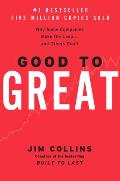 by Jim Collins
by Jim Collins
The good is the enemy of the best. Good enough is good enough. Then, when the water’s smooth and it’s a clear night out and everyone’s asleep in their cabins, it isn’t good enough anymore. In the face of a crisis, or with the insight into an impending crisis, some companies fold up, call it a good run, and go look for something else to do. Others start flailing and picking battles they can’t win. Still others go all ostrich-like as they fade from memory.
The winners move from good to great. What makes some companies go gently and others reform themselves is the subject of Jim Collins’s Good to Great: Why Some Companies Make the Leap…And Other Don’t. Collins identifies six basic characteristics of companies that make that transition, and posits a virtuous cycle of both confidence and competence that keeps things turning until takeoff: 1) Leadership that immerses itself in the company rather than seeing the company as evidence of its greatness, 2) a willingness to pick the right people first, even before setting new goals, 3) the stomach to look at the hard facts while retaining confidence in ultimate success, 4) a simple identification of a business mission, even though that mission may have many parts, 5) discipline, and 6) intelligent integration new technology into a successful business model.
Collins looked for companies that had done well for at least 15 years, and then, usually slowly at first, took off and beat the market by at least seven times over the next 15 years. He wasn’t looking for companies that had succeeded over decades, and he wasn’t looking for success that was the creation of one charismatic leader. Indeed, such leadership frequently prevents sustained success after that leader leaves.
Collins’s metrics are self-reinforcing. Non-egotistical leadership won’t be afraid to hire the best people first. It will be more likely to look and report facts straight, rather than feel threatened by them. A good business concept reinforces the discipline to stay away from tempting but destructive projects, and provides an economic measure for integrating new technology.
While Collins claims that all the elements are necessary for success, what struck me most was number 4), or what he calls, the “Hedgehog Concept,” after Isaiah Berlin’s famous essay. A great company needs not merely core competence, but something that people are passionate about, that will drive the company’s economic engine, and that it can be the best in the world at.
A Hedgehog Concept is clarifying. It helps decide on business opportunities, and to define operations. Walgreen’s defined their core business as convenient drugstores. But it also helped define their economic metric: profit per customer visit. Walgreen’s looked for convenient rather than cheaper locations, often closely clustering the stores in high-traffic areas.
Fidelity to the “Hedgehog Concept” doesn’t mean lack of innovation. Walgreen’s tried out the drive-through pharmacy and then built hundreds of them. It does mean integrating new technology into your existing business model. Instead of being spooked by drugstore.com, Walgreen’s incrementally developed Net technology to tie their stores together and create a useful online presence.
In fact, the Hedgehog Concept, like much of the book, is useful in almost any “soft” intellectual pursuit. Once you have the core lessons down, that framework is tremendously powerful in interpreting events and actions. It does not mean that there’s nothing left the learn. It does mean that you have gone a long way towards understanding what things mean, rather than just what they are. When Ronald Reagan died this last year, people often referred to him as a Hedgehog, since he had a few, very powerful ideas that drove his thinking.
One other note. I’ve read a fair number of business books, and it’s striking how many executives and authors are surprised by the violence of boardroom arguments. Veins bulging, faces reddening, papers flying, provided that you have the right people, this isn’t something to be afraid of, it’s how you get real buy-in. It’s easier to just nod, collect opinions, and impose some pre-determined solution, but the best managers will actually encourage this sort of confrontation. (This is different from encouraging competition, which can be destructive.)
Collins is readable, his research is well-defined, and his results have the ring of well-modified common sense. In the end, Good to Great is as clarifying as any good Hedgehog Concept.